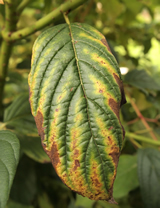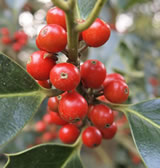

Ornamental plants
- Firm in plants which have been lifted by frost or strong winds.
- Brush the bulk of snow fall off conifers, evergreen shrubs and hedges so they don’t splay, but leave a small layer of snow in place as it can help to insulate the plant against harsh temperatures.
- Many shrubs can be pruned now, including roses, dogwoods, elders, buddleias, hydrangeas, cotinus, willows, mahonias and paulownias. Summer flowering clematis plants can also be cut back.
- Deadhead and generally tidy up winter bedding, pots and hanging baskets.
- Water and top dress containers which are out all year.
- It’s still too early to get your pots of spring bedding plants out, but you can start to harden them off towards the end of the month if it’s mild.
- Pot up dahlias and lilies to start them off in your greenhouse.
- Sow tuberous begonias, impatiens (busy Lizzies), osteospermums, pelargoniums, cannas and sweet peas under cover.
- If the weather’s bad outside, look through catalogues and order your plug plants.
- Warm up areas of soil where you want to plant early crops by covering them with polythene sheeting, cloches or fleece.
- Sow very early crops such as carrots, broad beans, hardy peas and parsnips under horticultural fleece.
- Chit early seed potatoes ready to plant them out at the end of next month.
- Plant soft fruit bushes, bare-rooted fruit trees and summer-fruiting raspberry canes.
- Prune autumn-fruiting raspberries and plant new canes this month or early March.
- If you have a greenhouse you can sow French beans, baby carrots, beetroot, radishes and spinach in the borders or in deep troughs. Lettuces (and other salad leaves), leeks, onions, early brassicas (eg spring cabbages), peas, broad beans, and early new potatoes can be sown in pots. You can start to sow tomatoes, aubergines and cucumbers in heated propagators for early crops.
- Try to keep off the lawn as much as possible. If necessary, put down a temporary path over frequently used areas.
- Finish up any winter digging, so long as the soil isn’t waterlogged or frozen.
- Keep your greenhouse well ventilated on milder days and keep watering to a minimum.
- Now’s a good time to design and create new beds and borders, ready for spring planting. It’s also an opportunity to do hard landscaping jobs or add a water feature to your garden.

Galanthus nivalis f. pleniflorus 'Flore Pleno' is valued for its large, double flowers which have a honey-scent. It flowers to 15cm tall in February and March. Clumps can be lifted and divided in the spring after flowering. Find out more...


Inter-veinal chlorosis is a distinctive symptom of nutrient deficiency which can have several causes. A lack of iron, manganese or magnesium can all cause this problem although each have slightly different indicators. Once the missing nutrient has been identified an appropriate fertiliser can be used to remedy the situation. Find out more...

Early slug warning for 2015
Dr Ian Bedford, head of entomology at the John Innes Centre, has predicted that 2015 will be another bumper year for slugs. If the current relatively mild weather continues then a larger number of slugs will survive the winter. Last year's mild winter saw a sharp uplift in the slug population, resulting in a 38% increase in slug killer sales by the end of August.
Looking slinky at Chelsea!
The Animal and Plant Health Agency has revealed details of their Chelsea 2015 show garden, designed by Sarah Eberle, which is going to include dozens of slinky toys. The springs will be hidden within the planting display, representing pests and diseases - the more you look the more you'll see!
New bluebell woodland in Staffordshire
Planting has begun in the new 'Branston Leas Wood', situated on the edge of the National Forest in Staffordshire. Creation of the woodland, which is part of a larger regeneration project, will involve planting 21,000 trees and 14,000 bluebell bulbs. Local residents, schools and colleges will be invited to plant a tree in the woodland over the next couple of months.

A bit of botany - safe sex in the plant world!
You may think that humans are the only species to exercise reproductive control measures, but in the plant world many different strategies are employed to ensure that breeding only happens at the right time and in the right way.
Pollination occurs when the male pollen (produced by the male sexual organ, the stamen) lands on the female stigma, the pollen then travels down the style in order to fertilise the ovule (egg). One of the principle ways in which plants control pollination is by the arrangement of the male and female sexual organs, which can be done in three different ways:
These plants have both male and female sexual organs in the same flower, so it’s likely that the egg will be fertilised by pollen from the same flower. Roses and echinaceas (shown below) are examples of a hermaphrodite plant.

Monoecious plants have separate male and female flowers, although they both grow on the same plant. The male pollen tends to be very light and the plant relies upon the wind to blow the pollen onto the female flowers. The common hazel, Corylus avellana, is an example of a monoecious plant.

Each dioecious plant only contains male or female flowers, therefore you need to have a male plant and a female plant in close proximity in order to produce fruit and seeds. Hollies (Ilex species) are dioecious, so if you want red winter berries (shown right) you’ll need to ensure that you have at least one male plant alongside your fruit-bearing females.
Other controls are also used to optimise pollination.
Here are a few example strategies:
- Opening flowers before leaves so that there isn’t any foliage to impede the pollen being blown from flower to flower.
- Having large, protruding stigma to catch the pollen as it floats past.
- Ripening the stigma (female) and stamen (male) at different times, or making them different lengths, so there’s less chance of self-pollination and the opportunities for cross-pollination are maximised.
- Having brightly coloured petals and scent to attract pollinating insects where the plant wants to increase the likelihood of self-pollination.
- Trapping pollinating insects inside the flower for a period of time to maximise the chances of self-pollination (eg the Arum lily).

What's on this month
Whether you want to face the cold, or keep warm indoors, we have a great selection of events for you to visit this month:
- All weekends in February - Snowdrops Open Days, Colesbourne Park, Colesbourne, near Cheltenham, Gloucestershire.
- 31st January to 8th February - Snowdrop Days, Chelsea Physic Garden, Chelsea, London.
- 7th February - Garden Writing Workshop, University of Oxford Botanic Garden, Oxford.
- 10th February - Cyclamen In Cultivation And In The Wild Talk With Garden Tour, Ashwood Nurseries, Kingswinford, West Midlands.
- 13th February - Insect Pollinators Talk And Tour, Cambridge University Botanic Garden, Cambridge.
- 14th & 15th / 21st & 22nd February - Snowdrop Weekends, Waterperry Gardens, Nr Wheatley, Oxfordshire.
- 16th February - Community Garden: Flower Power, The Bishop's Palace, Wells, Somerset.
- 19th February - Gardens And Landscapes In Northern Ireland, Shropshire Parks And Gardens Trust, Shropshire Wildlife Trust HQ, Shrewsbury, Shropshire.
- 19th February - Raising The Roof: The Story Of The Glasshouse At Wisley Talk, University of Bristol Botanic Garden, Stoke Bishop, Bristol.
- 20th & 21st February - RHS London Plant And Potato Fair, RHS Lindley Hall, London.
- 22nd February - Snowdrop Fair, Great Comp Garden, Sevenoaks, Kent.
- 27th & 28th February - RHS Garden Botanical Art Show, RHS Lindley Hall, London.
